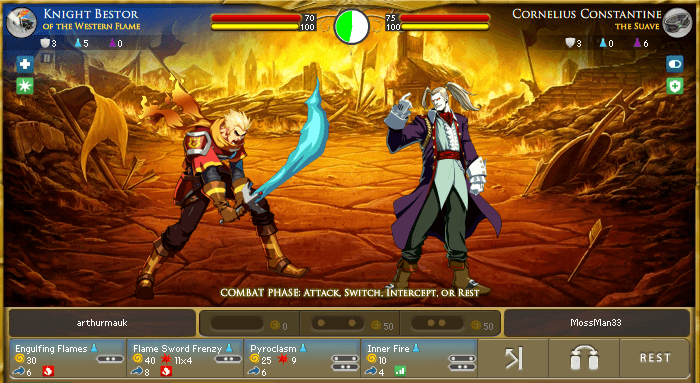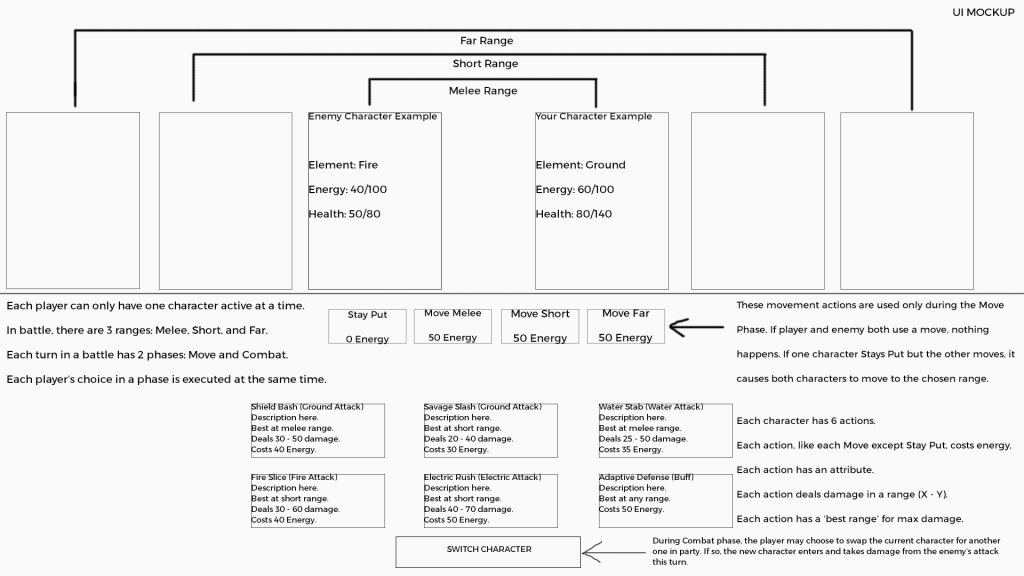Redesigning Kongai
Kongai is a turn-based double-blind (simultaneous play) card battler created by David Sirlin. Read more about it in Sirlin’s article Designing Kongai.
The game is largely dead at this time as no one plays it on Kongregate anymore, but I really enjoyed the ideas behind it and have been thinking of ways to create something that improves upon its design. I use the term improve as a matter of opinion here because design is largely subjective, and should David Sirlin stumble upon my blog he’s likely to defend his design in numerous ways based on his own opinion while criticizing my changes.
I’ll start with Kongai’s faults. The first one is a UI/UX issue, not actually a design problem.
- Unintuitive interface. When a new player plays for Kongai the first time, they see different attacks that cost energy and have varying levels of power. However, the user is not aware of the resistances the opponent’s character has because there is no obvious correlation between the meaning of the icons near the opponent’s character and the icon corresponding to each attack your character has.
- Multiple attacks don’t add much depth. This is an area of large subjectivity, but I found multiple attacks to be confusing at first (mostly because the way resistances work isn’t clear) and later when I finally understood them, I didn’t think they provided the level of depth and fun that Sirlin makes them out to be in his design article.
- Missing attacks is unfun. I don’t think missing attacks is ever fun, especially when they are associated with large energy costs that Kongai typically has. If you miss it should be a form of feedback based on your skill, such as missing in a FPS because your aim was off. When you miss in a turn-based game where aim is not really a skill, it feels artificial and unfun.
- Attacks are completely dependent on range. A large number of people may disagree with me here, but I felt attacks being disabled based on my range meant that the four attacks each character has is actually 1 or 2 attacks because half of them are usually disabled for not being in the proper range. I believe fun and viable choice are closely interrelated, and limiting options as opposed to limiting effectiveness is poor design.
- Too much of a guessing game. This is mostly a criticism of Sirlin’s preference for heavy rock-paper-scissors style design, whereas I believe balance should be more blurred. Switching causes your opponent’s attack to miss, and the only way to stop switching is to Intercept their switch. While this might have seemed great on paper, over time it just because a glorified guessing game where skilled players feel at crossroads with each other because the odds of making the correct choice against a low health opponent is always 50%. This form of skill gating is unnecessary and unfun.
Improvement Ideas
Here are the changes I am making. Further improvements may be added later on the more I discover.
- Single attacks with dual purposes. I’m removing multiple attacks entirely, and instead making single attacks have a dual purpose such as dealing damage and increasing the energy restored for one round or increasing resistance against a certain attribute. This removes the initial confusion behind multiple attacks and how they work while still adding a level of depth players can enjoy.
- Four elements. Kongai features Light, Dark, and Physical, but there’s no obvious match balance to those three. I’m changing the elements to Fire, Water, Ground, and Electric. The balance works out like this: Ground beats electric, which beats water, which beats fire, which beats ground. The only potentially unclear matchup here is that fire is strong against ground, but the rest are very intuitive.
- Each character has an element. Instead of each character having no element and a set of resistances (as in Kongai), each character now has a primary element and is both resistant to its own element and also capable of dealing more damage when using an attack that matches its element. In Pokemon, this is known as Same Type Attack Bonus (STAB). It also simplifies gameplay for the newer player since there aren’t a bunch of resistances to look up for each character, but instead only one resistance per character to be aware of. While some attacks will raise a resistance of a certain kind, this doesn’t make the gameplay more confusing because both players actively get a notification that the character’s resistance to one type has been raised. If little kids can handle Defense and Special Defense boosts in Pokemon, then I’ll argue similar usage here does not violate the burden of knowledge anti-pattern.
- Every attack is usable at any range, but damage is dependent on range. This addresses the issue that your choices in Kongai are actually very limited because some attacks are disabled due to range. I’m changing damage to not be a solid number but instead to be variable with a specified minimum and maximum. Damage dealt in combat is now dependent on the current range, and each attack will have a specified ‘most effective range.’ This expands viable choices per character and doesn’t make anyone feel gimped or fighting over range as opposed to actual combat.
- Adding another range. Kongai featured two ranges – close and far – but I’m adding a melee range and renaming ‘close’ to ‘short’. This is to further enhance the idea in Kongai that some characters are very good at close but terrible at far and vice versa because it provides a middle ground for those characters while also allowing me to introduce characters that actively seek short distance but don’t want to be in melee range.
- Attacks cannot miss and each character has a critical hit chance of 10%. I find missing to be unfun when there is no skill associated with it – if you miss in an FPS it’s because you actually missed, whereas missing in a turn-based game with no aiming feels artificial. My redesign will remove missing entirely, although some abilities may cause the next attack of a certain element to be blocked or heavily reduced in damage. Each character also has an internal, low critical hit chance since getting a critical hit is the kind of RNG that is actually fun. There might be a class or two that also has the ability to raise its critical hit chance in combat.
- Abilities per character can be customized. Instead of each character having a predefined set of abilities, the player will be able to choose abilities out of a pool available to all members of that character’s class. For example, all Archers might have access to a Fire Shot but the Fire Archer would utilize this skill best due to matching the ability’s element.
A New Setting
Kongai is a battler featuring numerous characters in a fantasy setting. I intend to keep the fantasy aspect, but also to supplement it by stealing the premise of the Fate series and the war for the Holy Grail. For those who are unfamiliar, each contestant in the Grail War summons a mythological hero fitting a certain class, such as Archer, Assassin, Berserker, etc. While each hero has its historical name, in the show they are referred to by class, so an Archer-class hero is actually called ‘Archer’ in the show as opposed to whatever name he or she had in history. Each contestant in the Fate series can only summon one hero, and losing that hero spells the end of that contestant’s quest for the Holy Grail (the contestant can also be killed, which causes the hero to disappear).
My redesign of Kongai is currently named Class Combat for prototyping and revolves around creating a party of 4 characters from different classes. Each class has numerous available characters, with each belonging to a different element. For example, Ground Archer, Fire Archer, Water Archer, etc. Stats-wise they are equivalent since the focus is not on a bunch of characters with unique stats, but instead balancing the distribution of elements in your party and choosing what attacks to assign. A Ground Archer deals more damage with ground attacks and is resistant to enemy ground attacks, but maybe you have a Ground Knight you want to use and your team is missing both a ranged fighter and someone who excels at Fire attacks, so you choose a Fire Archer with lots of Fire attacks. However, because Archers are typically weak, you plan to lead with your Ground Knight and switch to your Fire Archer when he will be most effective.
UI Mockup
I firmly believe any game that is actually fun can be played without art assets such as fancy graphics or audio. This is why I prototype my ideas in the most bare form (usually text only), because it allows me to see if they are mechanically where they need to be. Class Combat currently has no working prototype but I am developing one in my spare time. I’ll share a playable once a barebones version is ready.


